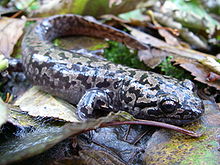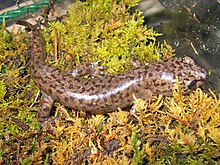Pacific giant salamander
| Pacific giant salamanders Temporal range: Paleocene to recent,
| |
|---|---|

| |
| Dicamptodon tenebrosus | |
| Scientific classification | |
| Domain: | Eukaryota |
| Kingdom: | Animalia |
| Phylum: | Chordata |
| Class: | Amphibia |
| Order: | Urodela |
| Family: | Ambystomatidae |
| Genus: | Dicamptodon Strauch, 1870 |
| Synonyms[1] | |
|
Chondrotus Cope, 1887 | |
The Pacific giant salamanders are members of the genus Dicamptodon. They are large salamanders endemic to the Pacific Northwest in North America.[1][2][3] They are included in the family Ambystomatidae,[1][4][5] or alternatively, in their own monogeneric family Dicamptodontidae.[2][3]
Description[edit]


Pacific giant salamanders are defined by their wide protruding eyes, costal grooves, thick arms, and dark background coloring. Dicamptodon have a snout-vent-length (SVL) of 350 mm, a broad head, laterally flexible flattened tails, paired premaxillae that are separate from the nasals, and the aquatic larvae have gills. Dicamptodon have lacrimals and pterygoids that are present, but quadratojugal are absent.[3]
While most salamanders are silent, the Pacific giant salamander is one of several salamanders that have vocal abilities. When startled, these salamanders may respond with a croaky-sounding cry similar to that of a barking dog.
Habitat[edit]
Pacific giant salamanders are semi-aquatic animals[6] that occupy both aquatic and terrestrial habitats. They are commonly found in various lotic environments in altitudes ranging from 0 to 7000 feet above sea level in the Pacific Northwest and Northern California. Aquatic salamander abundance has been shown to increase with increasing rock coverage, and decrease with increasing water velocity, and tend to prefer cold mountain streams and lakes.[7] Pacific giant salamanders also utilize terrestrial refuge sites such as decaying wood, burrows, or under rocks.[8]
Taxonomy[edit]
The genus Dicamptodon was formerly thought to contain two species, Cope's giant salamander (D. copei) on the Olympic Peninsula, Washington, and the Pacific giant salamander (D. ensatus) which consisted of three geographic populations, an Idaho isolate, a group in northern California, and a group in Oregon and Washington.[9] In 1989, genetic studies showed D. copei to be a distinct species, and the D. ensatus populations to consist of three species: the Idaho giant salamander (D. aterrimus) in Idaho, and two highly divergent species with a narrow hybrid zone in California, the coastal giant salamander (D. tenebrosus) (ranging from northern California to Washington), and the California giant salamander (D. ensatus) (limited only from Santa Cruz County to Mendocino County in California).[10] The earliest known member of this genus and family is D. antiquus from the Paleocene of Alberta.[11]
Extant species[edit]
There are four extant Dicamptodon species.[1][2]
| Image | Scientific name | Common Name | Distribution |
|---|---|---|---|
| Dicamptodon aterrimus | Idaho giant salamander | forested watersheds from lake Coeur d’Alene to the Salmon River, and in two locations in Montana around Mineral County, Idaho | |
 |
Dicamptodon copei | Cope's giant salamander | Olympic Peninsula to northern Oregon |
 |
Dicamptodon ensatus | California giant salamander | Northern California |
 |
Dicamptodon tenebrosus | Coastal giant salamander | Northern California, Oregon, Washington, and southern British Columbia. |
References[edit]
- ^ a b c d Frost, Darrel R. (2021). "Dicamptodon Strauch, 1870". Amphibian Species of the World: An Online Reference. Version 6.1. American Museum of Natural History. doi:10.5531/db.vz.0001. Retrieved 22 April 2021.
- ^ a b c "Dicamptodontidae". AmphibiaWeb. University of California, Berkeley. 2021. Retrieved 22 April 2021.
- ^ a b c Vitt, Laurie J. & Caldwell, Janalee P. (2014). Herpetology: An Introductory Biology of Amphibians and Reptiles (4th ed.). Academic Press. p. 463.
- ^ "Dicamptodon Strauch, 1870". Integrated Taxonomic Information System. Retrieved 22 April 2021.
- ^ "Dicamptodon Strauch, 1870". Global Biodiversity Information Facility. Retrieved 22 April 2021.
- ^ "Pacific Giant Salamander | Oregon Wild". oregonwild.org. Retrieved 2020-11-18.
- ^ "Pacific Giant Salamander". Burke Museum. Retrieved 2020-11-18.
- ^ "COSEWIC Assessment and Status Report on the Coastal Giant Salamander" (PDF). Committee on the Status of Endangered Wildlife in Canada. 2014. Retrieved November 17, 2020.
- ^ Ronald A. Nussbaum (1976-04-23). "Geographic variation and systematics of salamanders of the genus Dicamptodon Strauch (Ambystomatidae)" (PDF). Miscellaneous Publications. 149. Museum of Zoology, University of Michigan: 1–94. hdl:2027.42/56393.
- ^ David A. Goode (July 1989). "Hybridization and cryptic species in Dicamptodon (Caudata: Dicamptodontidae)". Evolution. 43 (4): 728–744. doi:10.2307/2409302. JSTOR 2409302. PMID 28564189.
- ^ "Fossilworks: Dicamptodon". fossilworks.org. Retrieved 17 December 2021.
External links[edit]
- Dicamptodon at CalPhotos

